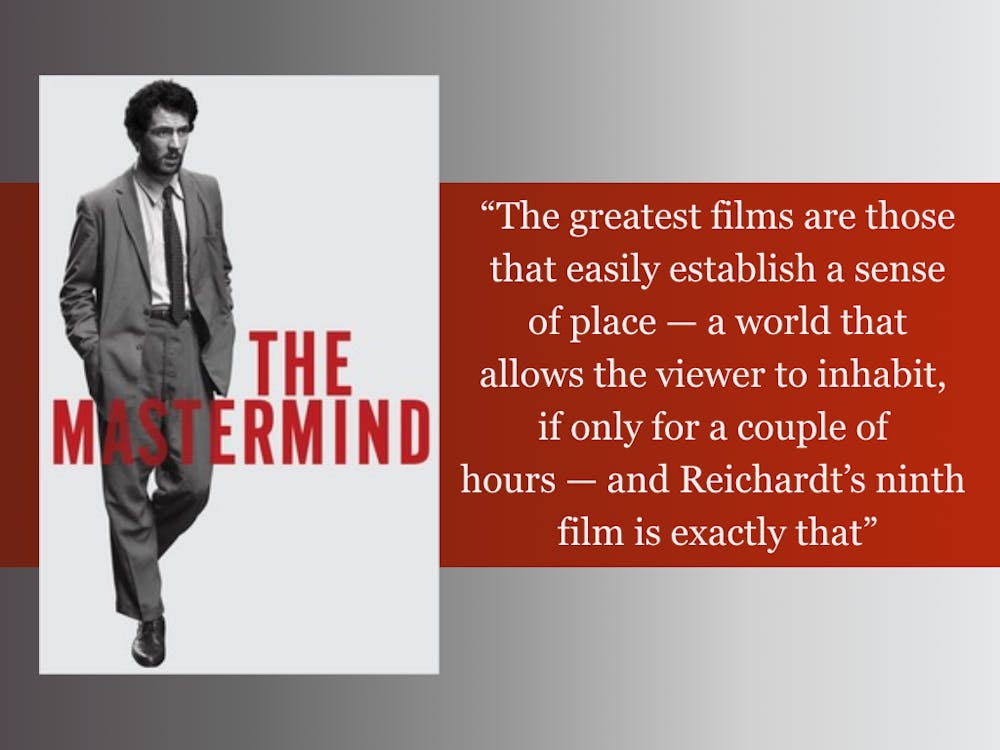Over the course of its lifespan, Hollywood has shown a simultaneous progression and regression. This has created public confusion regarding the “state of cinema” — constantly overtaking both public and industry conversations.
Is there a formula for filmmaking that directors and writers should adhere to? Or, on the contrary, must we constantly evolve the art form so as to remain relevant and original? The work of Kelly Reichardt, now more than ever, shows us that the answer is both.
Even among the trite, tepid and creatively-devoid output coming from contemporary Hollywood — whether in theaters or “straight to streaming” format — Reichardt guides us to a light at the end of the tunnel, where the creative reservoir of Hollywood isn’t entirely soaked up after all.
Her latest endeavor, the indie art heist film, “The Mastermind,” is a hilariously timely, politically-charged genre reconstruction that is simultaneously of the past and a look into the future. Although set in Massachusetts, the film possesses a Midwestern flair, or lack thereof (the film was largely shot in Hamilton and Cincinnati, not far from Miami University’s campus).
“The Mastermind” is — at its core — a heist film, in the same way Robert Bresson’s “Pickpocket” is, or in the way John Cassavetes’ “Gloria” is a crime thriller. That is, it’s a film composed of surfaces, and one that beckons to be peeled back to reveal more layers. And like the two aforementioned films, “The Mastermind” doesn’t adhere to a genre so much as it creates its own.
The film, set in 1970, follows a vagrant, unemployed carpenter and father of two, J.B. Mooney. He plans — and ultimately fails — at lifting four Arthur Dove paintings from his local art museum. Mooney is played by Josh O’Connor, the now well-known actor, whose turn as Mooney is eerily reminiscent of his leading role in the 2023 Italian film “La Chimera,” which found him playing a similarly disheveled drifter, albeit one that was much more physically dirty.
But in many ways, “La Chimera” can act as the ideal precursor to “The Mastermind.” If the former was about a man running from his past, and from grief itself, the latter is simply about a man on the run – from everything and everyone.
Where most films about a heist gone awry would build up exposition that culminates in a climactic heist near the end of the second act, Reichardt does the exact opposite: It shows the planning and undertaking of the heist within the first 20 minutes, leaving the audience with 90 minutes of comedown. But through her own structure, she forgoes the spellbinding shootout or car chase and replaces it with the mundanity of being the hapless fugitive, positioning all of the action out of center frame.
Reichardt intertwines political motifs that are recognizable across her entire filmography. Here, they manifest in a far more overt manner, in the form of Vietnam-era protests that occur both on a boxy television set and on the Massachusetts streets. The banality of Midwestern life, superimposed with wartime politics, only increases the relevancy of her work, both politically and artistically.
There is a notable scene that occurs shortly after the heist, where J.B. eats dinner with his family as they discuss the museum robbery, which was featured in the local paper. J.B.'s father, a prominent local judge, voices his disdain for the idea of stealing four abstract paintings from a local museum, despite his unawareness of his own son’s involvement.
The camera slowly drifts 360 degrees, landing on the other members of the Mooney family as they similarly give their two cents on the matter. Once J.B. is finally in frame, the camera settles and observes his quiet indifference, both to his own wrongdoings and to the world’s.
Through a shot like this, with all of its purposeful lack of editing and bone-dry humor laden throughout the film’s runtime, “The Mastermind” positions Reichardt at the intersection between a formalist and realist. But in this intersection, she oscillates between the two styles frequently, so that they eventually conflate into one, forming a new cinematic language that, despite its meandering pace, is impossible to look away from.
Enjoy what you're reading?
Signup for our newsletter
If it’s not obvious already, I may be glorifying “The Mastermind” and Reichardt as a writer and director more than I am trying to critique in any real sense. Without being overly influenced by its Midwestern autumn setting, chunky sweaters or Rob Mazurek’s jazzy, roseate score, I easily liken my viewing experience to that of an afternoon stroll in October.
The greatest films are those that easily establish a sense of place — a world that allows the viewer to inhabit, if only for a couple of hours — and Reichardt’s ninth film is exactly that, and more. It’s an oftentimes hilarious, intensely relevant film that beckons to reinvent the form, and by doing so, forge a path for a more hopeful future.
Rating: 10/10




